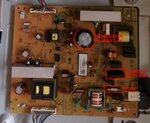Follow along with the video below to see how to install our site as a web app on your home screen.
Note: This feature may not be available in some browsers.

dear relayer,I appreciate this immensely and I'm glad I joined the edaboard community. Cheers. I'll do as said and send feedback with results. I hope it comes out positive.Hello psy,
If your device won't power up what-so-ever, then you need to check the main fuse to see if it has blown (See attachment).
You're going to need the aid of a multi-meter. If you don't own one then it will be virtually impossible to diagnose the fault
via pictures. Readings are needed to see what component/s are at fault.
If you do have a multi-meter, then set it to read low ohms and measure across the fuse to see if it is open circuit. But make sure
you DON'T have the power connected.
Before you start, make sure you discharge the main filter capacitor. You can identify the capacitor via the attachment. You can use
a screwdriver with an insulated handle across its two leads on the copper side of the board.
Now you can check the fuse and if you find that its a virtual short circuit, then the fuse is in tact and the problem lies elsewhere.
If the fuse is open circuit, then you need to check across the main filter capacitor. Same again, using your multi-meter selected for
low ohms, measure across the main filter capacitor leads. You may notice that it will start with low ohms, then it should build up to
an almost open circuit.
If you're getting a virtual short, then there's a good chance that the bridge rectifier has a short/s between its leads and would need to be replaced.
Can you please check what I've already suggested and let us know what you've found. We can then try to point you further.
Good luck.
Regards,
Relayer
View attachment 139129